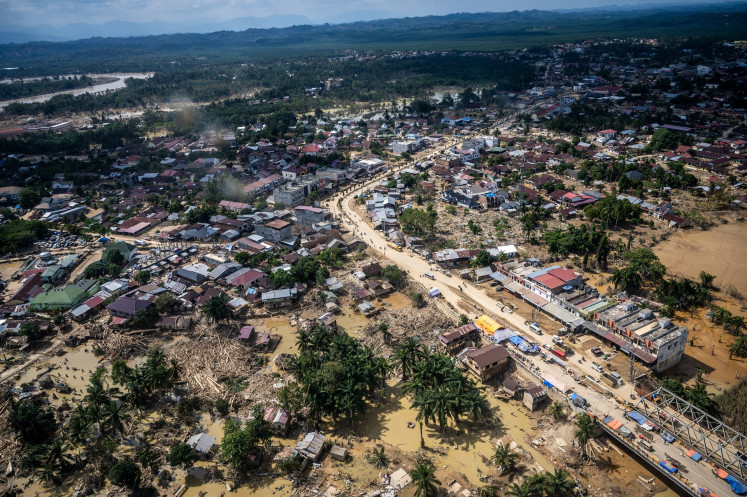Popular Reads
Top Results
Can't find what you're looking for?
View all search resultsPopular Reads
Top Results
Can't find what you're looking for?
View all search resultsInvesting in resilience crucial to change disaster landscape
Natural and manmade disasters, combined with the coronavirus pandemic, spell catastrophe.
Change text size
Gift Premium Articles
to Anyone
T
he Asia-Pacific region has been facing a series of humanitarian emergencies due to internal conflicts, natural disasters and now the pandemic.
Natural disasters alone are increasing both in frequency and intensity at an alarming rate, even in countries that are traditionally considered low risk are experiencing disasters.
“This pandemic has tested all health systems and national response capacities to the very limit,” revealed Tomoko Kurokawa, regional humanitarian adviser for UNFPA at the Asia Pacific regional office.
“All countries are at risk of collapsing without a sufficient health system support. Some countries in our region have had to deal with double and triple shots as they weathered overlapping natural disasters.”
The changing humanitarian landscape is even more relevant in the Asia-Pacific region, which she said was the most disaster prone region in the world and where the number of people affected by natural disasters was more than four times the rest of the world.
In 2018, she said 50 percent of all the 281 natural disasters occurring globally were in the Asia Pacific, with eight out of the 10 deadliest also in this region.
“We are already seeing the far reaching impacts of the pandemic on employment, economic downturn, protection of human rights, poverty, inequality and social unrest,” Kurokawa said.
“There has been an increase in maternal and neonatal morbidity and mortality, unmet needs for family planning and gender-based violence due to the pandemic.”
Kurokawa was a plenary speaker at the 10th Asia Pacific Conference on Sexual Reproductive Health and Rights (APCRASRH10) virtual conference on Humanitarian Response and Sexual and Reproductive Health and Rights (SRHR). It is part of the series organized by the steering committee of APCRSHR10, UNFPA and Citizen News Service (CNS).
Senior manager with Family Planning 2020 Secretariat, Chonghee Hwang, said emergencies were hard on everyone but the toll is especially heavy on the poorest and the marginalized and underserved members of the community.
“Women, girls and other marginalized groups face increased risk of unintended pregnancies, maternal mortality and disability, sexual-and gender-based violence, unsafe abortions and sexually transmitted infections, including HIV,” she said in her opening speech at the conference.
Even before the pandemic, Indonesia has always been prone to natural and manmade disasters since it sits on the Pacific Ring of Fire – an arc of volcanoes and fault lines encircling the Pacific Basin, making it one of the world’s most seismically active regions prone to tectonic and volcanic eruptions, earthquakes to tsunamis.
With the coronavirus taking its tight grip globally, including in Indonesia, home to nearly 270 million people, it spells catastrophe.
In 2018, Indonesia recorded 4,089 disasters, including earthquakes, tsunamis, floods, land liquefaction and landslides, which left 8,439 people dead or missing.
The National Disaster Mitigation Agency (BNPB) also recorded 9,384 disasters killing 684 people in 2019 and this year, it has recorded 2,346 disasters, leaving 76 people dead.
The pandemic has shown no slowing down either, with the Health Ministry announcing that the total number of infections nationwide stood at 415,402 as of Monday. The virus has killed 14,044.
The pandemic has also put the country’s SRHR programs to test. The National Population and Family Planning Board (BKKBN) said in March that some 10 percent of its 28 million beneficiaries faced difficulty in accessing birth control and many clinics had been shut while those open limited the number of people they served.
The BKKBN estimated that a one month decline in contraceptive use alone in Indonesia, which welcomes around 4.8 million births annually, could push pregnancies up by 15 percent, or around 420,000 pregnancies, within three months.
Despite the imminent risk of disasters, Indonesia, which is set to host the United Nations Office for Disaster Risk Reduction’s Global Platform for Disaster Risk Reduction in 2022, is more focused on post-disaster than risk-prevention measures, which is far more common and costly.
Former head of Gadjah Mada University's disaster studies center, Djati Mardiatno, previously told The Jakarta Post the importance of preventing disasters than allocating all the resources to post-disaster measures.
"The principle of disaster prevention is similar to the widely recognized motto in the medical community that preventing an illness is better than curing it," he said.
"[The necessary] investment in measures to prevent disasters or reduce their impacts will be much smaller than the budget funds needed for post-disaster recovery and rehabilitation activities."
Moving forward: Innovation showcases resilience to address the continuity of sexual reproductive health information and services provision across the region. (Courtesy of UNFPA Asia Pacific Regional Office/-)Kurokawa said humanitarian crises affected health, social protections and livelihoods, which in turn compounded existing inequalities and socioeconomic vulnerabilities.
“This creates a vicious cycle of poverty, inequality and disasters which must be broken to prevent disasters from reversing hard earned development gains,” she said.
She said the frequency of natural disasters compounded by the impacts of protracted crisis required resilience and development perspective, as well as a continuum approach across the humanitarian development peace building nexus in pursuit of collective outcomes that were sustainable and meaningful.
“Investing in resilience helps prevent and curtail economic, environmental and human losses in the event of a crisis,” Kurokawa said.
“Building resilience of women and girls is a shared responsibility across all sectors with gender equality and the empowerment of women and girls at the very heart and center of principled and effective humanitarian action.”
As a demonstration of resilience, she said there are examples of innovation to address the continuity of SRH health information and services provision across the region.
In Pakistan, for instance, a women’s safety app was upgraded as an innovative solution for challenges of mobility and gender based violence during the lockdown, while in Afghanistan a youth health line has reached over 5,000 young people providing adolescent SRH information and services.
In Mongolia, telemedicine services were set up to provide quality SRH services by practicing licensed physicians and in the Philippines through “a condom heroes programs”, a free condom delivery service is now running for people in lockdown.
“The constant shocks and threats that affect this region require us to demonstrate our own resilience […] and always placing the empowerment of women, girls and young people at the core of this work to build resilience and ensure sustainability,” Kurokawa said.











